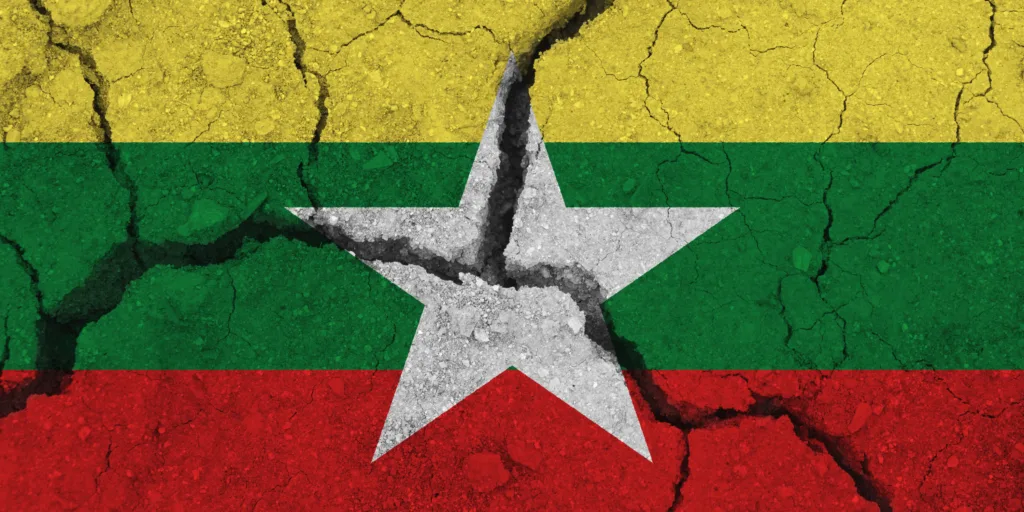The devastating earthquake in Myanmar has exposed the junta’s mismanagement.
Key takeaways:
-
Myanmar’s military regime has prioritized its interest in fueling the war and maintaining political control over disaster preparation, worsening the earthquake devastation.
-
Discrimination under the junta has left minority communities more vulnerable to the earthquake’s impact.
-
The military’s post-quake response shows continued mismanagement and disregard for the Myanmar people.
Already struggling under the weight of the world’s longest-running civil war, genocide, war crimes, and climate-related disasters, Myanmar was struck by a devastating earthquake on March 28th. The magnitude 7.7 tremor, centered along the Sagaing Fault, caused a slip of up to five meters within just ninety seconds. This catastrophic event, followed by a magnitude 6.4 aftershock, wreaked havoc across major cities, including Mandalay, Nay Pyi Taw, and Sagaing, as well as historic towns such as Ava and Amarapura. Even in Yangon, hundreds of miles away, people fled into the streets as buildings swayed violently.
By May 9th, Myanmar’s military-run state media had reported over 3,800 deaths, with more than 5,000 injured. However, local sources suggest the actual toll could be significantly higher, with the US Geological Survey estimating that the final death count could exceed 10,000. In response, the military junta declared a week of national mourning, with flags flown at half-mast until April 6th.
Seismologists Judith A. Hubbard and Kyle Bradley noted that, “As with all great earthquakes on known active faults, this M7.7 earthquake was both completely expected (the location and magnitude), and completely unexpected (the timing).” This observation raises a critical question: What disaster risk reduction (DRR) measures, if any, did Myanmar have in place before the quake, and how has the government handled disaster management in its aftermath?
Myanmar military’s mismanagement
Since gaining independence in 1948, Myanmar has been dominated by military rule, which has profoundly shaped its political landscape. From direct military governance and the so-called Myanmar Way to Socialism to a power-sharing arrangement under the 2008 Constitution, military control has remained a central feature. The 2008 Constitution granted the military 25% of parliamentary seats, control over key ministries, and the power to nominate a vice president. However, in 2021, the military, led by third-generation dictator Min Aung Hlaing, staged a coup that overthrew the democratically elected government of Aung San Suu Kyi.
Since seizing power, the junta has severely undermined Myanmar’s disaster risk management and climate adaptation efforts, which had been gradually developed under semi-democratic administrations between 2011 and 2021. Despite adopting the National Disaster Management Law in 2013, the military has largely ignored the Myanmar National Framework for Community Disaster Resilience, a critical guideline for building community-level disaster preparedness.
The Myanmar Action Plan on Disaster Risk Reduction was once a vital blueprint for enhancing community resilience and preparing for natural disasters. However, following the 2021 coup, the junta shifted its priorities dramatically, diverting vast resources to its military operations. In the fiscal year 2024-25, the military allocated a staggering 41 trillion kyats (≅ €17.38 billion) to sustain its ongoing civil war—a record-high figure—while quietly siphoning 400 billion kyats ≅ €169.6 million) from the Myanmar National Disaster Management Fund. Initially intended for disaster relief, this money was rerouted into the State Economic Promotion Fund, aimed at propping up an economy battered by international sanctions. In essence, the junta prioritized its grip on power over protecting its citizens from foreseeable disasters.
This raises a critical question: If scientists had long warned of the seismic risks along the Sagaing Fault, why did the military divert essential disaster funds elsewhere? How frequently were residents in cities like Mandalay, Nay Pyi Taw, or Sagaing provided with earthquake awareness programs or preparedness drills? While the collapse of ancient pagodas, mosques, and churches can partly be attributed to their age, the structural failure of modern buildings, such as the Sky Villa and the newly built Buddhist monastery complex in Mandalay, exposes glaring deficiencies in enforcing construction regulations.
Additionally, this disaster highlights broader concerns about the rule of law in Myanmar. Were construction sites properly inspected to ensure compliance with building standards? Did negligence play a role in the collapse of buildings that should have been able to withstand seismic shocks? Or is systemic corruption—from high-ranking officials like Min Aung Hlaing down to junior officers—ultimately responsible for these failures? The military’s mismanagement of disaster preparedness and infrastructure safety further underscores its incompetence as a governing body.
Moreover, the higher death toll from last year’s Typhoon Yagi in Myanmar, despite the storm striking indirectly, compared to Vietnam, a country directly in the typhoon’s path, serves as another stark example of the military’s failure in disaster response and management.
A Nationalist agenda and systemic discrimination
The military’s nationalist agenda and decades-long discriminatory policies have also exacerbated the earthquake’s devastation. Centuries-old mosques, many of which had been denied even basic maintenance, such as leak repairs to prevent water damage, suffered extensive damage. Reports indicate that over 130 mosques were destroyed, with more than 700 Burmese Muslims dying during Friday prayers. This disproportionate death rate compared with just 5% of the Burmese Muslim population in Myanmar highlights deliberate neglect and systemic discrimination, the military’s direct responsibility for preventable deaths, exposing its failure to protect all communities during a disaster.
This raises another critical question: In the aftermath of the earthquake, will the military permit the rebuilding of collapsed mosques and churches, or will its oppressive policies continue to obstruct the restoration of vital places of worship for minority communities? The answer to this question will determine whether the junta is genuinely willing to support all communities in their recovery or whether it will persist in its pattern of exclusion and discrimination.
The military’s recent actions are telling—it has refused to allow international media into Myanmar to cover earthquake updates, continued bombing civilian areas, rejected a ceasefire request from revolutionary forces, and blocked a Taiwanese rescue team from assisting victims. Additionally, it made the controversial decision to reschedule the national Grade 12 examination on June 16th for students in earthquake-affected regions, such as Mandalay and Sagaing, following the destruction of their original answer sheets in a fire at Mandalay University caused by the earthquake. While the students have no responsibility since they have done what they need to do, these inhumane actions reflect a regime disconnected from the needs of the people it claims to govern, showing little concern for the suffering of its citizens.
Despite saffron washing itself as the protector of Myanmar and its dominant religion, Buddhism, the military’s actions have plunged the country into a state of polycrisis, exacerbating both natural and man-made disasters. Its reckless mismanagement and discriminatory policies have left Myanmar more vulnerable to future disasters, revealing the depth of its governance failures.
Conclusion
The military’s failure to prioritize disaster preparedness, mismanagement of vital resources, and systemic discrimination are the underlying causes of the catastrophic damage caused by the earthquake in Myanmar. As the country struggles to recover, it is painfully clear that the military’s incompetence has deepened the crisis, leaving its citizens to bear the brunt of the devastation. The junta’s refusal to address these systemic issues and its continued disregard for the well-being of Myanmar’s diverse communities make it increasingly clear that it is unfit to govern. It must be held accountable for its failures, as the evidence of its mismanagement continues to mount.






